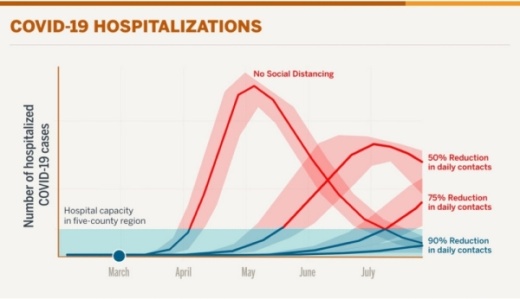This is according to COVID-19 modeling data released by the University of Texas at Austin and related Austin-Travis County public health efforts.
Data from UT’s pandemic model shows reducing daily contacts by up to 75% may not be sufficient to prevent an unmanageable surge in COVID-19-related hospitalizations in the five-county area that includes Bastrop, Caldwell, Hays, Travis and Williamson.
A 90% reduction, however, could be sufficient. On March 24, Travis County and city of Austin officials announced stay-in-place orders went into effect March 25 until April 13.
“The takeaway from this analysis is that the extent of social distancing measures and our willingness to adhere to them will directly impact not only the fate of the outbreak but also our capacity to provide life-saving health care for those in need,” said Lauren Ancel Meyers, a professor of integrative biology and statistics and data sciences who prepared the initial results.
Austin Mayor Steve Adler, Travis County Judge Sarah Eckhardt and Interim Austin-Travis County health authority Dr. Mark Escott led a press conference March 26 to discuss the implications of the newly released figures.
“This is critical information to have because it really helps us to frame the importance of social distancing,” Escott said, insisting that returning to business as usual is not an option for Central Texas. “This data is not perfect, but it’s as perfect as we can get right now.”
If the advice laid out in the modeling is not followed, the Greater Austin area could face a shortage of 20,000 hospital beds in the next month and a half, Escott said.
Eckhardt congratulated residents for achieving a 50% reduction in personal interactions so far, but stressed that it is not nearly enough and implored everyone to ask themselves before leaving the house if what they are about to do is essential.
“If it is not, stay home,” she said.
Though the COVID-19 crisis is hurting the region economically, there is no greater resource than residents' health and well-being, Eckhardt said.
Adler echoed the results of the modeling and said Central Texans have a choice to make, and admonished people for continuing to gather in public, citing recent public photos on social media showing large gatherings at Barton Springs.
Escott said the 90% reduction in interaction essentially means that if a person is now interacting with 10 people per day, they should reduce that figure to one person per day.
“Remember, the disease is dangerous, but it’s most dangerous when it spreads quickly,” Escott said and referenced the current infection rate in New York.
Asked if Austin and Travis County’s current stay-at-home order is intended to have citizens meet the 90% reduction, Escott said officials will have to wait and see.
With regard to enforcement of non-essential businesses staying open, Adler said this, along with other measures, is something residents have to enforce themselves. Eckhardt said that although enforcement is important, officials have to give people the information so that they can make the best decisions and hold each other accountable.
“Enforcement by law enforcement will be a last resort,” she said.
Right now, health officials have the ability to expand bed capacity, including reappropriating other spaces such as hotels, Escott said. Austin area officials, he said, are working with regional officials to make sure bordering rural communities with fewer resources have the help they need.





